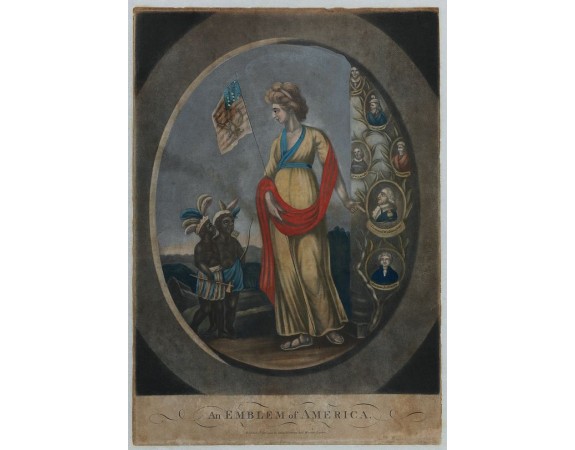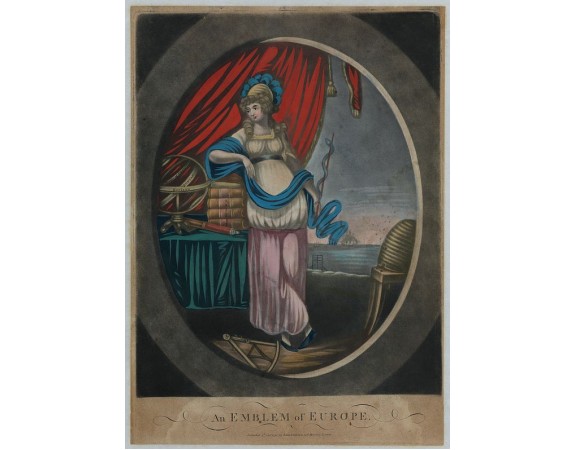FAIRBURN, John. - An Emblem of America / An Emblem of Africa / An Emblem of Asia / An Emblem of Europe.
 Click on image to zoom
Click on image to zoom


FAIRBURN, John. - An Emblem of America / An Emblem of Africa / An Emblem of Asia / An Emblem of Europe.
Published: London, 1798
Size: 360 x 255mm.
Color: Colored
Condition: Four mezzotints extensively handcoloured with watercolor and gouache. Slightly browning, restored and applied on Japan paper.
Description
An Emblem of America : This white female figure of Columbia, emblematic of the United States, represents America in a set of prints of the Four Continents. Standing beside her are two dark-skinned boys wearing feathered head-dresses representing the Western Hemisphere, she directs their gaze to the column decorated with oval portraits of the individuals, who ‘discovered’ America, as well as the founders of the new nation. The list includes Christopher Columbus, “Americus” Vespucci, Sir Walter Raleigh, George Washington, Benjamin Franklin and John Adams.
Shortly after the British North American colonies gained independence from England in the late-eighteenth century, the female figure of Columbia became synonymous with American identity. However, personifications of North America developed as early as the sixteenth century, with early modern artists depicting Europe, Asia, Africa, and the Americas as female figures in prints, paintings, and sculptures. Artists depicted Europe as illustrious and cultivated to glorify its greatness, whereas, artists depicted North America as unrefined and uncivilized. America(s), depicted as an "Indian Princess," often wore a feathered headdress, feathered skirt, and a bow and arrow. The figure was regularly situated within a tropical landscape, sometimes holding a parrot or sitting on an enlarged alligator or oversized armadillo, based on their own ideas of Indigenous life in North America. By the eighteenth century, as the New World became less threatening to Europe, artists and allegorists began portraying North America as the neoclassical, white, female figure that became known as Columbia.
The African American child beside Columbia, dressed in the guise of a Native American figure, may be a representation of the "noble savage" trope. A highly offensive term first appearing in seventeenth century literature, the "noble savage" referred to someone who lives in nature, uncorrupted by civilization. French philosopher Jean-Jacques Rousseau later embraced the concept to highlight the corruption of European civilization in much of his eighteenth century discourse. Americans similarly embraced the stereotype after gaining Independence, as many artists in the late-eighteenth-and early-nineteenth-centuries created romanticized and falsified images of Indigenous peoples. The "primitive" and "simple" life of the ennobled "savage," many artists believed, juxtaposed the corruption of urban civilization
The African American figure in the painting might also be represented as a child on account of the dominant caricatures that depicted people of color as children in the eighteenth-and nineteenth-centuries. These offensive and harmful portrayals were intended to justify slavery, by instilling a paternalistic attitude in white masters and perpetuating the belief that they could serve as parental figures for enslaved people. This not only justified chattel slavery, but made it appear morally righteous. Regardless of whatever symbolism the artist had intended for the allegorical figures in this painting, it is no doubt suggestive of the widespread belief that people of color were considered lesser-than in the new nation.
An Emblem of Asia : Figurs a female figure wearing a turban with the Koran in his right hand. In the background are a pyramid, camels and an elephant with a palanquin.
An Emblem of Africa : Figurs a dark-skinned man with a bow and arrows wearing a turban and jewelry. In the background we can see a landscape with a river and near the figure a tent and a palm tree.
An Emblem of Europe : A female figure, leaning on books of fine arts surrounded by scientific instruments such as an armillary sphere, a spyglass and a sextant, holds a staff of Aesculapius in her left hand, the symbol of the traveler. In the background, we can see ships and a caravel sailing on the sea. All these elements symbolize European culture, travel and navigation.
Shortly after the British North American colonies gained independence from England in the late-eighteenth century, the female figure of Columbia became synonymous with American identity. However, personifications of North America developed as early as the sixteenth century, with early modern artists depicting Europe, Asia, Africa, and the Americas as female figures in prints, paintings, and sculptures. Artists depicted Europe as illustrious and cultivated to glorify its greatness, whereas, artists depicted North America as unrefined and uncivilized. America(s), depicted as an "Indian Princess," often wore a feathered headdress, feathered skirt, and a bow and arrow. The figure was regularly situated within a tropical landscape, sometimes holding a parrot or sitting on an enlarged alligator or oversized armadillo, based on their own ideas of Indigenous life in North America. By the eighteenth century, as the New World became less threatening to Europe, artists and allegorists began portraying North America as the neoclassical, white, female figure that became known as Columbia.
The African American child beside Columbia, dressed in the guise of a Native American figure, may be a representation of the "noble savage" trope. A highly offensive term first appearing in seventeenth century literature, the "noble savage" referred to someone who lives in nature, uncorrupted by civilization. French philosopher Jean-Jacques Rousseau later embraced the concept to highlight the corruption of European civilization in much of his eighteenth century discourse. Americans similarly embraced the stereotype after gaining Independence, as many artists in the late-eighteenth-and early-nineteenth-centuries created romanticized and falsified images of Indigenous peoples. The "primitive" and "simple" life of the ennobled "savage," many artists believed, juxtaposed the corruption of urban civilization
The African American figure in the painting might also be represented as a child on account of the dominant caricatures that depicted people of color as children in the eighteenth-and nineteenth-centuries. These offensive and harmful portrayals were intended to justify slavery, by instilling a paternalistic attitude in white masters and perpetuating the belief that they could serve as parental figures for enslaved people. This not only justified chattel slavery, but made it appear morally righteous. Regardless of whatever symbolism the artist had intended for the allegorical figures in this painting, it is no doubt suggestive of the widespread belief that people of color were considered lesser-than in the new nation.
An Emblem of Asia : Figurs a female figure wearing a turban with the Koran in his right hand. In the background are a pyramid, camels and an elephant with a palanquin.
An Emblem of Africa : Figurs a dark-skinned man with a bow and arrows wearing a turban and jewelry. In the background we can see a landscape with a river and near the figure a tent and a palm tree.
An Emblem of Europe : A female figure, leaning on books of fine arts surrounded by scientific instruments such as an armillary sphere, a spyglass and a sextant, holds a staff of Aesculapius in her left hand, the symbol of the traveler. In the background, we can see ships and a caravel sailing on the sea. All these elements symbolize European culture, travel and navigation.
1,700€
- Reference N°: 49091
